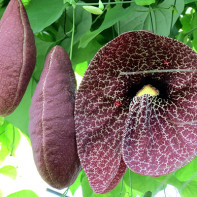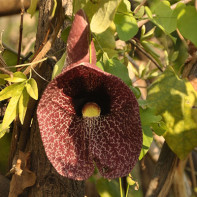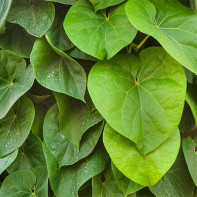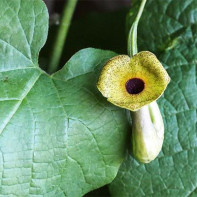Kirkazon: medicinal properties and contraindications
Cirsazone is a plant in the family Circazon. It is not only able to favorably decorate the plot, but also has many useful properties. This plant is considered one of the oldest on earth. Its healing properties have been known to mankind for many centuries.
- Chemical composition
- How it looks and where it grows
- Types of
- Harvesting and storage
- Care
- Growing
- Ornamentals for landscaping
- Omen and Rituals
- Therapeutic Properties of Kirkazon
- Kirkazon in folk medicine
- For gynecological diseases
- For douches
- For the treatment and prevention of cancer
- In the treatment of joint and cardiovascular diseases
- For colds
- For insomnia
- For wounds and pustules
- For wound healing
- For psoriasis
- For Immunity
- Honey Pills
- Pyeongchonghwan
- Madurenhwan
- Contraindications for use
- Interesting Facts
Chemical Composition
The plant acquired its medicinal properties due to its unique chemical composition, which includes:
- bitter and tannins;
- essential oil and esters;
- phenolic and aristolochic acids;
- saponins;
- glycosides and lactones.
The different species may differ in their chemical composition, but they all contain large amounts of aristolochic acids and their compounds. Most are used in folk medicine to treat various ailments. The most poisonous species is considered to be the pickleweed, because the concentration of acid in it is the maximum.
What it looks like and where it grows
The curcasone is a single-trunked perennial vines-like plant with bright, large and very beautiful leaves. It is perennial and grows and develops for up to 30 years. Its branched root system is relatively close to the soil surface. The lightly branched shoots can grow to a height of 14 m. The stems, which are woody from below, grow vertically. The young shoots have a smooth greenish-brown bark which begins to crack over time and turns brown. The ornamental leaves are very ornamental to the plant. The leaf plate is large arrow-shaped, heart-shaped and palmate, depending on the species. The color ranges from light green to deep green. The leaf length can vary from 5 to 30 cm. The leaves themselves are arranged alternately and form a continuous cover.
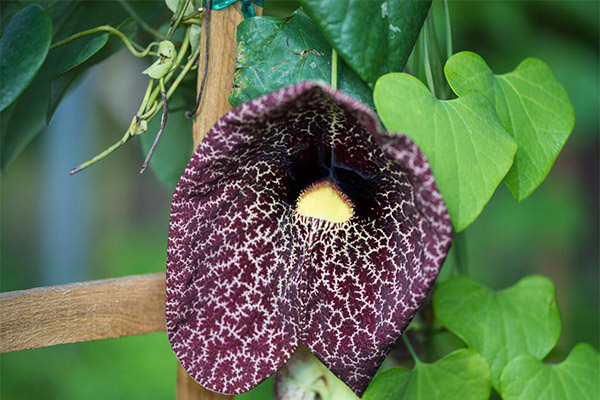
Depending on the species, the flowering time is from May to October and lasts 20 days. The axillary flowers can grow either singly or in groups. These curved tubes are similar in shape to a pitcher, into which the insects fall. The flowers are very characterized by an unpleasant rotten smell, this is due to the fact that the pollinators are mostly flies. Flowering does not begin until it is five years old. The characteristic color of the petals is red, yellow and brown-red. The seed bolls are hanging, elongated or rounded in shape. Each contains many seeds.
Mostly cypress grows in temperate and tropical climates in Asia, America and Africa. In Russia, it can be found in the North Caucasus and the Far East, as well as in the European part of the country.
Species
In total, there are more than 200 species of pickleweed. Let's consider the most popular ones.
- Common pickleweed. The folk name is fever grass. Refers to perennial plants. Height - from 30 to 60 cm. It has a creeping rhizome and a simple, slightly bent stem. Leaf large, pronounced ovate shape with a matte surface that has a roughness. The edge of the leaf is blunt. The pear-shaped fruits break up into individual dry fruits. The flower is dangling, light yellow in color, with a characteristic fruity odor. The flowering period is from late spring to mid-summer. Most often this species can be found in the Central Black Earth Region. It grows along river banks, on slopes and edges. All parts of the common pickle are used for medicinal purposes.
- Large-leafed Aristolochia. In appearance, a typical large liana with smooth bark of a marsh-green color. With age, the bark cracks and turns a light brown color. The green leaves are heart-shaped and up to 30 cm in diameter. A characteristic feature is the mosaic coloring due to the fact that the leaves on one shoot differ in shade. Leaf fall occurs in the fall period. Flowering time is early summer. The seed pods have an oblong appearance.
- Manchurian cilantro. A woody liana up to 15 m long with dark green downy leaves of large size hanging down. The leaves are up to 30 cm long and have a pointed shape. The bark is soft, mostly dark gray. The smell of camphor oil is due to the location of glands on the leaf itself. The fruit has a cylindrical shape, resembling a hexagonal box. As it ripens, the color changes from bright green to yellowish green. The flowering period is in early May. At this time, axillary flowers of brown and cream color bloom on the vines. In fall the leaves fall off. Most widely represented in the Far East region of Russia. You can find Manchurian pickle in forests and near streams. It likes damp buds and shady areas. Like the common species, it is widely used in folk medicine. Due to its exotic beauty, it is often used to decorate park and garden areas.
- Felted Kirkzon. A climbing plant up to 10 m tall. Distinguished by its beauty and flawlessness. It gets its name from the dense covering of young leaves and shoots with felted nap. Leaves are light green in color and reach a length of 16 cm, the shape is ovate. In the axils of the leaves are tubular flowers, which are yellowish-purple in color. This species is the most thermophilic. The flowering period is the beginning of summer.
- Cirsasone graceful. An evergreen liana. One of the most beautiful species. Its homeland is considered South America. Its closest relatives are the large-leafed and Manchurian pickaxons. A distinctive feature - large heart-shaped leaves. The arrangement of the buds is single or in groups of 4-6. As a rule, it blooms in the middle of summer. The flowers are large, reaching a length of 12 cm and a width of 8 cm, in shape very much like a gramophone pipe. The magnificent rowan color is able to attract the attention of even the most avid gardener, not to mention ordinary amateurs. Ideal for landscaping the streets and decorating the garden plot.
- Curled Kirkazon. The length of the herbaceous liana can reach 1 m. The root, unlike other species, is small and rounded. The bark exudes a pungent odor and is colored yellow. The leaf is not very large, about 3-7 cm long, slightly elongated triangular-cordate in shape. Flowers are small, branched. The fruit has a pronounced oval shape. Seasonal flowering time falls in July and August. Roots and fruits are used for medicinal purposes. Particularly popular in Chinese and Korean medicine, the fruit of this species is called "maduren" in China. The main place of growth is in the Far East. Usually grows in thickets, not far from water bodies.
- Steipa curcasona. One of the rarest species. It grows only in certain sparse areas. In Russia, this species can be found in the south of the country in the Krasnodar Territory. It is so rare that it is included in the Red Book of the southern region. This herbaceous plant is distinguished by its small size, unlike its larger brothers. Its height is no more than 25 cm. The leaf has an ovoid-round shape, its length does not exceed 10 cm. The rhizome is represented by a tuber, rounded shape, with a diameter of 8-10 cm. As a rule, the first leaf already appears at the beginning of March. The flowering period falls in the middle and end of spring. The small saxophone-shaped flowers are very brightly colored, usually red and all its shades. It exudes a foul odor that can be compared to meat that is already far from stale. In addition to the Krasnodar region, this species can be found in the northwestern part of the Caucasus, in the forests, but it also adapts well in the dacha-garden area. Due to its bright flowers, the plant attracts attention and surprises with its beauty. But, unfortunately, the number of this species decreases rapidly from year to year.
Gathering and storage
Cirsasone has many medicinal properties. For medicinal purposes, both the above-ground and underground parts of the plant are used. But the seeds are used very rarely. To get the maximum benefit, it is necessary to collect correctly. It is important to cut the leaves and stems during flowering and dig up the roots in the fall. The top part of the plant should be dried in a well-ventilated room, while avoiding direct sunlight.
Rinse the dug up roots thoroughly with cold water, wait for the moisture to dry completely, if necessary blot with a paper or cloth towel. Sort thoroughly: remove thin and rotten roots. Slice, and then send for drying in an oven preheated to 60 degrees, or a special drying chamber.
Properly dried plant stored in a closed container in a dark place. For storage is better to use paper boxes. The medicinal properties are preserved for 2 years. After the specified period is not recommended to use the raw material because of the loss of all medicinal properties.
It is strongly recommended to collect the plant in rubber gloves, since, in addition to useful substances, the pickle contains and poisonous.
Care
The plant is unpretentious, but, as for any other representative of the flora, it is necessary to observe some recommendations for care:
- Watering should be moderate, both drying of the soil and its excessive moisture should not be allowed.
- Fertilize several times a season, as a fertilizer use the most common cowpea, diluted with water in a ratio of 1:10.
- Loosen carefully, as the root system of the pickle is close to the surface.
- Be sure to cut off the dried leaves and shoots.
- Place the plant in the shade, as it does not like direct sunlight.
- When selecting a planting place, take into account that strong gusts of wind are contraindicated to the pickerel, which can damage the thin stems.
Growing
Propagation takes place by root taps, cuttings and seeds. Preparation of cuttings is better to begin in the spring or autumn period. To do this, you need to cut 20-cm shoots with a few buds. Place the cuttings under a slope in sandy soil. Plenty of watering and regular fertilization is required. Before the first leaves appear, it is necessary to cover with a transparent cap.

A simpler way of cultivation is by means of branches. It is only necessary to press the shoot to the ground, and a year later, when it takes root, safely cut it off from the main plant and transplant it to another place.
Depending on the species in the open ground planted in spring or autumn. It is important to observe the main rule: the distance between the plants should be at least 1 m, as the root system in the pickle is wide. The depth of the planting hole - no more than 50 cm. Be sure to put drainage and sprinkle sand on the bottom. After planting, abundantly water with organic fertilizers. Since the plant is liana-like, it is necessary to install a pole next to it, on which the pickle will weave.
An interesting feature: The weaving is always counterclockwise.
The pickleweed grows very quickly. In the warm season, it can grow by 15 cm in just one day. The average annual growth rate is 2-3 m.
Ornamentation of the landscape
Gardeners are very fond of applying the plant when decorating the landscape design. The curcasone is rightly considered the best greenery for vertical surfaces. Liana is characterized by fast growth and density. It is often used to create the effect of a living green blanket on houses, fences, arbors. With proper shaping, you can get a luxurious arch or even a tunnel. The liana looks very effective when decorating the trunks of old trees and columns.
True fact: The shape of the leaf of the classic pickaxe was taken as a model for ornamentation in Gothic architecture in past times.
Omens and rituals
Almost all representatives of the plant world, people over the years have invented and created legends associated with omens and rituals. Such an ancient plant, such as the coriander, of course, could not avoid human attention. It is believed that with its help, a representative of the male sex can attract the attention of a woman you like or, on the contrary, destroy a love relationship.
Therapeutic properties of pickleweed
Even the ancient Greeks were well known and successfully used the pickleweed for medicinal purposes.
The plant has the following medicinal properties:
- antipyretic;
- antibacterial;
- anti-inflammatory;
- diaphoretic;
- diuretic;
- wound-healing;
- expectorant;
- sedative.
Due to its medicinal properties, it is actively used for the treatment and prevention of joint diseases - gout, rheumatism, osteochondrosis:
- Joint diseases - gout, rheumatism, osteochondrosis, the cause of which was the deposition of salts.
- Many pathologies of the gastrointestinal tract, including diarrhea.
- Cardiovascular system problems: heart rhythm malfunctions, high blood pressure, vegetovascular dystonia.
- Women's gynecological disorders: it reduces the tone of the uterus, is included in the treatment of erosions, cysts, polyps and myomas.
- Colds, flu, acute respiratory infections, as well as the initial stage of tuberculosis.
- Kidney disorders: normalizes their activity, cleanses them of toxins and other harmful substances.
- Skin diseases of different origin - dermatitis, eczema, psoriasis.
- Tumors.
- Varicose veins and thrombophlebitis.
- Nervous and emotional stress, insomnia.
Ornamentum in folk medicine
For therapeutic purposes, the cilantro is used in several forms:
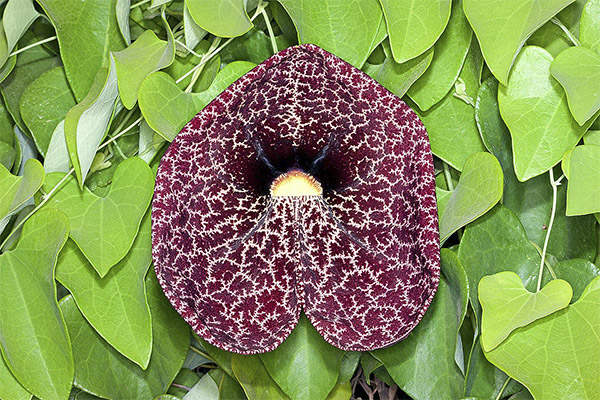
- Tincture. Mix 1 tsp of dried plant with 100 grams of vodka. Insist in a dark cool place for 7 days. Shake regularly, at the end of seven days squeeze. Apply 3 times a day at 20 drops.
- Infusion. One glass of water will need 2 tsp. dried mixture. After 5 hours, strain. Use internally 2 spoonfuls after meals.
- Ointment. Need to mix 100 grams of crushed plant with pork belly fat. Transfer to a jar, leaving the top two finger lengths. Warm in a water bath for several hours. Apply externally 2 times a day. Be sure to store the finished ointment in the refrigerator.
- Decoction. Apply for external use. Dry root of 1 tsp. pour 200 ml of boiling water and keep on low heat for 30 minutes. Use as needed in compresses and for rinsing.
The following are the most popular recipes for specific diseases.
In gynecological diseases
This composition is used internally in gynecological diseases. You will need 300 ml of cool boiled water and 2 tsp. of dried pickle juice. Insist overnight, filtered in the morning. Use several times a day for 2 tbsp. The course of treatment is 2 months.
For sprinkling
Infusion of pickleweed is actively used for douches for problems of the female genital system. To prepare a miraculous infusion, you will need 3 tbsp of pickleweed, 1 tbsp of celandine and 1 l of boiling water. After an hour, strain. The procedure of douches should be performed daily before going to bed for 10-12 days.
For the treatment and prevention of cancer
Since aristolochioic acids are capable of producing a powerful antitumor effect, scientists are considering the use of tools based on kirkazon for the treatment and prevention of cancer. Unfortunately, no such medicines have been released so far. But folk medicine offers an equally effective recipe to fight cancer cells.
When cancer metastases develop in the body, you need to mix the following ingredients: half a cup of ground pickle root, 2 tablespoons of sour cream, one cup of honey and 3 liters of cool water. Stir thoroughly and leave for a week in a dark, cool place. Use internally every day at 100 grams, 15 minutes before a meal.
The treatment of joint and cardiovascular diseases.
Recipe: 1 teaspoon of Kirkazon pour 2 cups of boiled cold water. Pour everything into a thermos and leave overnight. In the morning, strain the infusion. Take a quarter cup after 30 minutes after a meal.
From colds
A decoction of a glass of water and ½ tsp of the herb helps well with colds and gastrointestinal problems. Pre-cook for 20 minutes over low heat, strain. Use 1 tbsp. 4 times a day.
For insomnia
To combat insomnia and nervous tension take this highly effective remedy: pour a glass of cold boiled water of 250 ml in a thermos, add 1 tsp. of pickle. Insist overnight. Take strained. The recommended initial dose - 1 tsp. 4-5 times a day before meals, gradually increasing the dosage to 2 tsp.
With wounds and pustules.
With wounds and pustules, mastitis proved a positive reputation medicinal baths Kirkazon. Pour 2 tbsp. dried herbs with a cup of boiling water, put on low heat for 15 minutes. Strain, add to the bath with pre-collected water. Water temperature should not be below 35 and above 38 degrees. The time of the procedure is 20 minutes.
For healing wounds.
To relieve irritation on the skin and increase the rate of wound healing will help a miracle ointment: mix lard with crushed roots of pickaxe, in a ratio of 5:1, boil on a water bath for 2 hours. Rub into the affected areas 2-3 times a day.
For psoriasis
A cream prepared in accordance with the following recipe will help get rid of psoriasis. Only three ingredients are needed: 4 tbsp comfrey, 2 tbsp of pickle juice and 100g of melted pork fat. Mix everything, use daily. It is important to test for allergic reactions before the first use: apply a small amount of cream on the inside of the wrist. If the skin will appear redness and characteristic itching, you should not use the cream.
For immunity
To enhance the immune system and normalize the gastrointestinal tract take a tincture prepared as follows: ground rhizomes pour 70% alcohol in a ratio of 1:3. Leave for 21 days in a well-closed container. Take 3 times a day at 20 drops.
Honey Pills
An interesting and effective recipe using the plant of cyrcasone from the Chinese folk healers has the traditional name - "Honey Pills". To prepare healing pills will require the fruit of twisted pickle. It is necessary to use this species and no other. This is fundamentally important, since the fruits of this species are less toxic.
So, you will need: 3 mature fruits, which should be thoroughly grinded into a powder. It is better to use a mortar for this purpose. Then add honey syrup to the kirkazon powder. To obtain it, dissolve 2-3 tbsp. honey in a glass of hot water. Then put the honey-quirkazone solution to simmer on low heat. The readiness can be determined by the thickening of the honey. As soon as it begins to stick to your hands, remove the container from the fire and send it to cool in a well-ventilated place. This is an indispensable and highly effective remedy for respiratory diseases. Apply 3-9 grams daily until fully recovered.
Currants are widely used not only in Chinese but also in Korean folk medicine.
Pyeongchonhwan .
The name of the Korean curcasone remedy bears the beautiful name "Pyeongchonhwan". To prepare it, crush the fruits of the kirkazon, Korean bellflower, Chinese lemongrass, as well as the leaves of the perilla and the upper stems of the actractylis. Add to the crushed herbs any antiseptic and liquid honey. Take in bronchitis, asthma and tuberculosis in a single dose of 3-5 grams. Daily dose should not exceed 15 g.
Madurenhvan .
In Korea, another remedy, Madurenhwan, which includes pickleweed, is used. It, like the previous one, is used to treat problems related to the human respiratory system. The composition includes: Korean bell, coriander (fruits), mulberry root bark, leaves of the already familiar perilla, lily stems. All ingredients are crushed and mixed. Use 3 times a day for 2 tsp.
When swelling, Korean herbalists also prescribe decoction of twisted pickleberry to patients.
Contraindications to use
Despite the miraculous medicinal properties of curcasone, we should not forget that this plant still belongs to the poisonous and with excessive and improper use can not only cause serious poisoning, but also cause great harm to the whole body.

There are a number of diseases in which the strictly contraindicated use of drugs, which include cankerwort:
- uterine bleeding;
- Pregnancy and lactation;
- Acute renal and hepatic failure;
- gastritis and other inflammations of the gastrointestinal tract, especially in the acute stage;
- menorrhagia;
- hemorrhagic nephritis.
Under no circumstances should children be allowed near the pickle. Due to the content of poisonous substances, the plant is capable of causing not only allergies, but also a serious burn.
Until now, there are still debates between educated physicians and representatives of folk medicine. On the one hand, there are facts of life that confirm the presence and effectiveness of the medicinal properties of the plant of caraway grass. On the other hand, numerous studies have shown that the plant has a strong carcinogenic and mutagenic effect on the human body. On the territory of the Russian Federation and many other countries, this plant is recognized as a capillary poison, and its use is prohibited in the manufacture of medicines.
But despite all the bans, people continue to actively use kirkazone infusions, ointments and creams for their treatment. Numerous positive reviews of Internet users confirm the effectiveness and miraculous properties of these remedies. In regular pharmacy chains you will not be able to buy dry pickings of pickle, as well as medicinal preparations, which include this plant. You can buy it only from homeopaths and folk healers.
Of course, each person decides for himself how and with what he is treated. The main thing is to remember that in everything and always in moderation. When treating herbal tinctures and decoctions is very important to observe the correct dosage and buy medicinal products only from trusted herbalists. After all, to collect herbs in the right place and at the right time can not every person. In order to really get an effective treatment with the help of folk medicine, and not to harm your body, you need to follow all the rules of collecting, preparing and storing herbal ingredients.
Interesting facts
- Few people know, but in England the plant has the name "Dutch pipe". And this is not surprising, because the shape of the flower of the pickle is very reminiscent of this smoking device.
- The unpleasant smell of the plant exudes because it is pollinated by insects that feed on dead animals (flies, beetles and others). If you carefully study the coloration of flowers of any of the species, you can see the similarity of color shades to the missing meat.
- The curved shape of the flower is not accidental, but directly related to the pollination process. Once inside, it is difficult for the insect to get out, and getting out of a peculiar trap, it has to lose the pollen it brought.
«Important: All information on this site is provided for informational purposes only. for educational purposes only. Consult with a specialist before using any of the recommendations. specialist before you use any of the recommendations. Neither the editors nor the authors are liable for any possible harm caused by materials."

